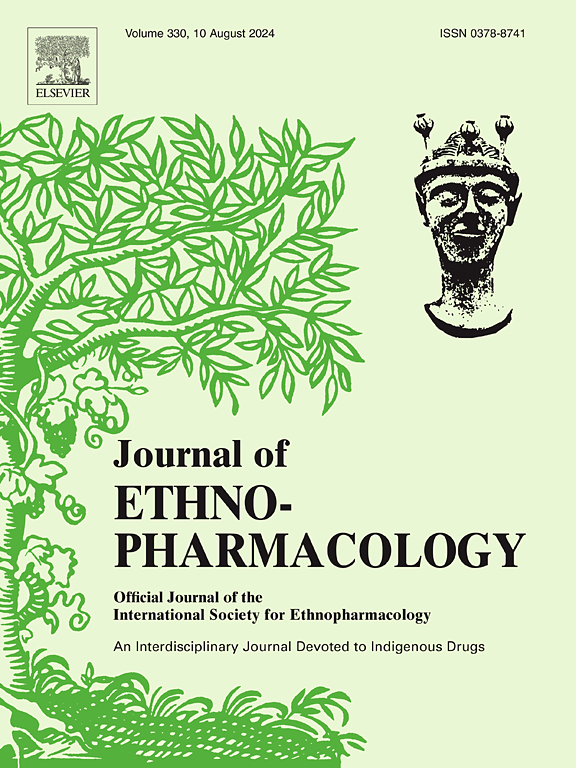The role of miR-146a/IRAK1/JNK1 pathway in mediating the effects of Yiqi Congming decoction on dry eye: A mechanistic study in rat models
IF 4.8
2区 医学
Q1 CHEMISTRY, MEDICINAL
引用次数: 0
Abstract
Ethnopharmacological relevance
Yiqi Congming Decoction (YQCM) is a traditional Chinese medicine formula widely used as a complementary and alternative therapy for dry eye and other ophthalmic disorders.
Objective
This study aims to investigate the potential effects of YQCM on dry eye and to identify the active components responsible for its therapeutic efficacy using a rat model.
Materials and methods
Using Ultra-High Performance Liquid Chromatography/Quadrupole Time-of-Flight Mass Spectrometry (HPLC-QTOF/MS), the chemical constituents of YQCM were identified. In vivo experiments demonstrated the protective effects of YQCM on the corneal barrier in a rat model of dry eye and determined the optimal therapeutic dose. YQCM and agomiR-146a were administered either individually or in combination to rat over 14 days, followed by evaluations of Schirmer I test (SⅠT) results, tear film breakup time (BUT), fluorescein staining (FL) levels, corneal epithelial cell inflammation, and apoptosis. Furthermore, the expression of proteins in the miR-146a/IRAK1/JNK1 pathway, as well as inflammation and apoptosis-related proteins, was examined to explore the mechanisms through which YQCM modulates inflammation and improves tear film stability. In vitro experiments employed serum containing YQCM, agomiR-146a, and the IRAK1 inhibitor (AZ1495) to further investigate the regulatory effects of YQCM on the miR-146a/IRAK1/JNK1 pathway and its impact on inflammation and apoptosis in human corneal epithelial cells (HCECs) under hypertonic conditions.
Results
In vivo experimental results demonstrated that YQCM significantly restored tear film stability. Treatment with varying doses of YQCM improved corneal epithelial damage in rats, with the medium dose exhibiting the most pronounced effect. YQCM increased the SⅠT and BUT levels, effectively reduced FL levels, and inhibited apoptosis and inflammatory damage in corneal epithelial cells. Additionally, scanning electron microscopy, hematoxylin-eosin (HE) staining, TUNEL assays, and Western blot (WB) and qPCR analyses revealed that YQCM significantly ameliorated corneal damage in dry eye rats and reduced the expression levels of MMP-9, TNF-α, IL-1β, Caspase-3, IL-6, and IFN-γ. Moreover, YQCM modulated the expression of proteins in the miR-146a/IRAK1/JNK1 pathway. In vitro experiments demonstrated that YQCM regulated the levels of miR-146a/IRAK1/JNK1 in HCECs under hypertonic conditions and enhanced cell viability by reducing the expression of MMP-9, TNF-α, IL-1β, Caspase-3, IL-6, and IFN-γ. Using Annexin V-FITC/PI double staining and other techniques, it was further confirmed that YQCM alleviated apoptosis in HCECs under hypertonic conditions.
Conclusion
YQCM protects tear film stability in a rat model of dry eye by suppressing corneal epithelial inflammatory responses and reducing apoptosis through modulation of the miR-146a/IRAK1/JNK1 pathway.

miR-146a/IRAK1/JNK1通路在益气从明汤治疗干眼大鼠模型中的作用机制研究
民族药理学相关性:益气从明汤(YQCM)是一种被广泛应用于干眼症和其他眼部疾病的补充和替代疗法的中药配方。目的:通过大鼠模型,探讨益心方对干眼症的潜在作用,并鉴定其治疗干眼症的有效成分。材料和方法:采用超高效液相色谱/四极杆飞行时间质谱法(HPLC-QTOF/MS)对yqqcm的化学成分进行鉴定。体内实验证实了YQCM对大鼠干眼模型角膜屏障的保护作用,并确定了最佳治疗剂量。YQCM和agomiR-146a分别或联合给予大鼠14天,随后评估Schirmer I试验(SⅠT)结果、泪膜破裂时间(BUT)、荧光素染色(FL)水平、角膜上皮细胞炎症和凋亡。此外,我们还检测了miR-146a/IRAK1/JNK1通路中蛋白的表达,以及炎症和凋亡相关蛋白的表达,以探索YQCM调节炎症和改善泪膜稳定性的机制。体外实验采用含有YQCM、agomiR-146a和IRAK1抑制剂(AZ1495)的血清,进一步研究高渗条件下YQCM对miR-146a/IRAK1/JNK1通路的调控作用及其对人角膜上皮细胞(HCECs)炎症和凋亡的影响。结果:体内实验结果表明,YQCM能明显恢复泪膜的稳定性。不同剂量的YQCM治疗可改善大鼠角膜上皮损伤,其中中剂量效果最明显。YQCM提高SⅠT和BUT水平,有效降低FL水平,抑制角膜上皮细胞凋亡和炎症损伤。此外,扫描电镜、苏木精-伊红(HE)染色、TUNEL、Western blot (WB)和qPCR分析显示,YQCM显著改善了干眼大鼠角膜损伤,降低了MMP-9、TNF-α、IL-1β、Caspase-3、IL-6和IFN-γ的表达水平。此外,YQCM可调节miR-146a/IRAK1/JNK1通路中蛋白的表达。体外实验表明,YQCM通过降低MMP-9、TNF-α、IL-1β、Caspase-3、IL-6和IFN-γ的表达,调节高渗条件下HCECs中miR-146a/IRAK1/JNK1的水平,提高细胞活力。通过Annexin V-FITC/PI双染色等技术进一步证实了YQCM对高渗条件下HCECs细胞凋亡的缓解作用。结论:YQCM通过调节miR-146a/IRAK1/JNK1通路,抑制角膜上皮炎症反应,减少细胞凋亡,从而保护大鼠干眼模型泪膜稳定性。
本文章由计算机程序翻译,如有差异,请以英文原文为准。
求助全文
约1分钟内获得全文
求助全文
来源期刊

Journal of ethnopharmacology
医学-全科医学与补充医学
CiteScore
10.30
自引率
5.60%
发文量
967
审稿时长
77 days
期刊介绍:
The Journal of Ethnopharmacology is dedicated to the exchange of information and understandings about people''s use of plants, fungi, animals, microorganisms and minerals and their biological and pharmacological effects based on the principles established through international conventions. Early people confronted with illness and disease, discovered a wealth of useful therapeutic agents in the plant and animal kingdoms. The empirical knowledge of these medicinal substances and their toxic potential was passed on by oral tradition and sometimes recorded in herbals and other texts on materia medica. Many valuable drugs of today (e.g., atropine, ephedrine, tubocurarine, digoxin, reserpine) came into use through the study of indigenous remedies. Chemists continue to use plant-derived drugs (e.g., morphine, taxol, physostigmine, quinidine, emetine) as prototypes in their attempts to develop more effective and less toxic medicinals.
 求助内容:
求助内容: 应助结果提醒方式:
应助结果提醒方式:


